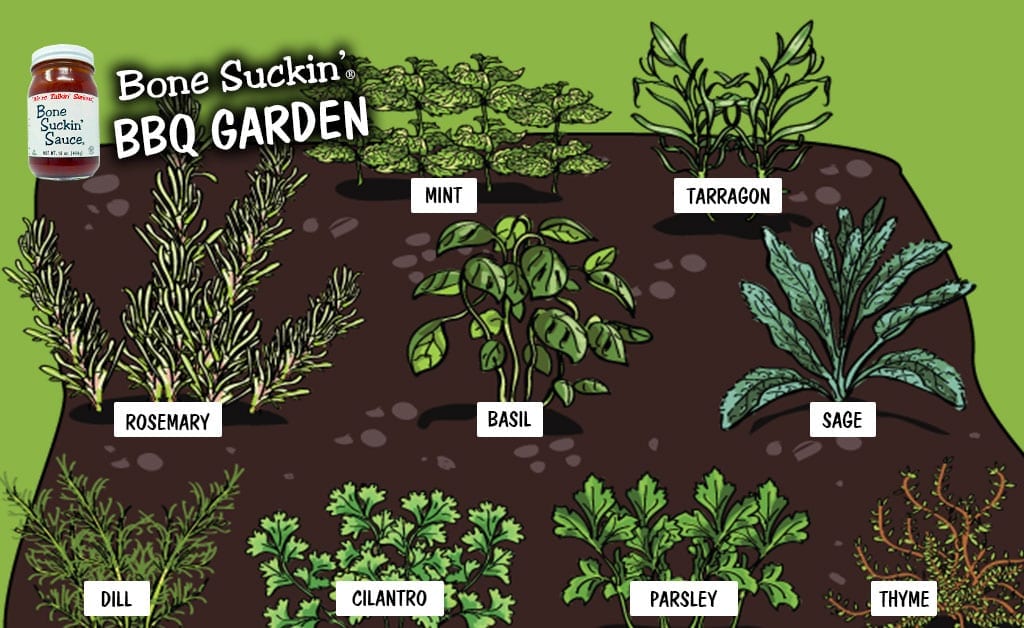
Planting a barbecue herb garden can be easy & fun
If you are unsure of digging up a part of your yard for this, then plant in containers. Container gardening offers mobility, easy access and beauty, plus you get more bang for your buck. Most any kind of a container can be used for container gardening. Making sure that the container has good drainage is the most important thing. Different heights, widths and even colors can make the garden interesting. Just be aware that the smaller the container, the faster that the plants will dry out. Another thing to consider is to keep plants that share the same kind of watering, sun and soil preferences together. For instance, rosemary, thyme, sage and basil like to dry out between watering, where as parsley, chive and mint prefer more moisture.
Start by picking a sunny spot, preferably near your grill or kitchen, so the picking is easy. Most herbs need about 6 hours of sun a day, but that means morning sun preferably. The sun during the hottest part of the day will scorch most plants and dry the containers out, so make sure that the plants are shaded during the hottest part of the day. Make sure that the soil used is high quality potting soil that has good drainage. Most herbs are happier when they are not fertilized, but if you feel you must, make sure that they have been watered first. Putting fertilizer on plants that have not been watered will burn the roots and kill the plant.
Pick plants that you find yourself cooking with the most. Basil might be a real favorite to use in the summertime with tomatoes. Rosemary might be an herb that you not only cook with, but like the look and fragrance. There are not many rules in container gardening other than mixing the plants that have common soil, water and sun preferences.
There are perennial and annual herbs. The perennial herbs come back year after year. Perennial herbs include Mint, Rosemary, Thyme and Sage. Annuals or biennials last one to two seasons and need to be replanted each season. Annual herbs are Parsley, Dill, Cilantro and Basil. Each has its own value for cooking. Now to the herbs and what herbs you might want in your own container garden.
 Rosemary
Rosemary
Rosemary is an aromatic herb that is a must have for a barbecuing garden. It has a lemony and almost bittersweet flavor. The plant is typically bushy and depending on the variety (and there are many), can grow as tall as 3 feet or more. Not only are the leaves used in grilling lamb, chicken and frittatas, but the woody stems are great for skewers. Rosemary loves drier sandy or rocky soil and other than pruning, can be left alone.
 Thyme
Thyme
Thyme is a great herb that is not too overpowering. Plant Thyme in a hot, sunny location with well drained soil and it will thrive. Low growing, it is best planted in the front part of the garden or along the edges of a container. It also tolerates drought well, which is helpful in the South. Thyme is used as an ornamental as well as for its culinary purposes. Garden Thyme and Lemon Thyme are the most common varieties and can be used fresh or dried, fresh always being the more potent of the two. Thyme is primarily used with lamb and fish, but can be used with most any meats, soups and stews. It is also a wonderful source of iron. Bees are really attracted to Thyme, when in flower.
 Tarragon
Tarragon
Tarragon is a tall herb that should be planted toward the back of the garden. It tends to favor well drained soil in a sunny spot in the garden. Tarragon is great fresh or dried. In fresh form, it like most herbs and is more flavorful, but it is also more perishable. Luckily it is very easy to dry in sprigs tied and hung in dark place, such as a garage or shed. It also retains most of its flavor too. Tarragon is used frequently in and on salads, stews and grilled meats.
 Basil
Basil
Basil is an annual herb that is used on already prepared foods. When fresh, but cooked, it quickly loses its flavor. Unlike the above herbs, it is grown as an annual and is sensitive to cold. Basil can be started from seed or can easily be bought from a nursery as a more mature plant. It will begin as a bushy plant and can grow very tall and leggy, so constant pinching of the plant will promote growth. Basil is a great addition to salads, pizzas and pasta dishes.

Parsley
Parsley is a biennial and is common in most herb gardens. It can be difficult to start from seed, so buying from a nursery as a young plant is recommended. Parsley comes in two varieties, curly and flat leaf, also known as Italian Parsley. The curly is the most commonly known and often used in garnishing, as well as cooking. The flat leaf however has a stronger flavor. So when in doubt, plant both, that way you will have enough for salads, dressings and garnishes. The only problem that most gardeners have with parsley is that the plant is well loved by the Swallow-Tailed Monarch Butterfly. They will appear as a small caterpillar and begin gnawing away at the parsley and become very large. Just remove them by hand; the plant usually rebounds from their munching.
 Cilantro
Cilantro
Cilantro is a real favorite in the herb garden and is a relative of parsley. The plant can grow to about 18 to 24 inches in height. All of the cilantro plant is edible: leaves, stems, and even the seeds. The seeds are also known as Coriander and used in Asian cooking. Cilantro is frequently used in U.S. Southwestern, Latin, Mexican and Asian cooking and is known for its pungent, sometimes soapy taste. Grown in full sun, like parsley, it likes moist, well drained soil.
 Dill
Dill
Dill, another member of the parsley family, is an annual that likes full sun and well drained soil. It is an easy herb to grow and the leaves as well as the seeds are flavorful. As the plant grows, pinch or snip the lacey leaves back at the point of the main stalk to promote bushiness and growth. If left alone, the dill can grow to a height as great as 3 feet, bloom and produce seeds. Dill is most familiar as a pickling spice, but it enhances the flavors of food as well as compliments other herbs when combined. The seed has a tendency to be stronger in flavor, but both the seed and leaf are wonderful with fish, vegetables, breads and dips.
 Sage
Sage
Sage is used in flavoring and seasoning dressing, meats, vegetables and cheese. It is a hardy perennial in most states, and will tolerate full sun, sandy soil and drought conditions. Sage is known for its gray to purple, soft, fuzzy leaves, is low growing and perfect for borders in containers or gardens. The older the leaf, the stronger the flavor and much like Rosemary, a little goes a long way.
 Mint
Mint
Mint is a must have in an herb garden. Whether you plant spearmint or peppermint, it does not matter for both are used in meats, such as lamb, salads and beverages. However, of all the herbs listed above, this hardy perennial is best planted in a container. It can become very invasive and quickly become a pest. If kept in a container, it can be constantly pruned and still come back readily. Mint loves rich moist soil and requires little care.
All of these plants listed are herbs that can be planted in containers and grow beautifully together. The most important rule about planting herbs in a container is that when planting different herbs in the same pot, remember to keep the plants together that have the same sun, soil and watering preferences together. Herbs are beautiful and delicious, planted together conveniently in containers near your kitchen or barbecue grill. So, get started and plant away.
